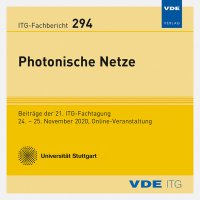Mode-locked laser timing jitter limitation in optically enabled, spectrally sliced ADCs
Konferenz: Photonische Netze - 21. ITG-Fachtagung
24.11.2020 - 25.11.2020 in online
Tagungsband: Photonische Netze
Seiten: 5Sprache: EnglischTyp: PDF
Autoren:
Zazzi, Andrea; Mueller, Juliana; Witzens, Jeremy (Institute of Integrated Photonics, RWTH Aachen University, Aachen, Germany)
Gudyriev, Sergiy; Scheytt, J. Christoph (Heinz Nixdorf Institute Paderborn, University Paderborn, Germany)
Marin-Palomo, Pablo; Fang, Dengyang; Koos, Christian (Institute of Photonics and Quantum Electronics, Karlsruhe Institute of Technology, Karlsruhe, Germany)
Inhalt:
Novel analog-to-digital converter (ADC) architectures are motivated by the demand for rising sampling rates and effective number of bits (ENOB). The main limitation on ENOB in purely electrical ADCs lies in the relatively high jitter of oscillators, in the order of a few tens of fs for state-of-the-art components. When compared to the extremely low jitter obtained with best-in-class Ti:sapphire mode-locked lasers (MLL), in the attosecond range, it is apparent that a mixed electrical-optical architecture could significantly improve the converters’ ENOB. We model and analyze the ENOB limitations arising from optical sources in optically enabled, spectrally sliced ADCs, after discussing the system architecture and implementation details. The phase noise of the optical carrier, serving for electro-optic signal transduction, is shown not to propagate to the reconstructed digitized signal and therefore not to represent a fundamental limit. The optical phase noise of the MLL used to generate reference tones for individual slices also does not fundamentally impact the converted signal, so long as it remains correlated among all the comb lines. On the other hand, the timing jitter of the MLL, as also reflected in its RF linewidth, is fundamentally limiting the ADC performance, since it is directly mapped as jitter to the converted signal. The hybrid nature of a photonically enabled, spectrally sliced ADC implies the utilization of a number of reduced bandwidth electrical ADCs to convert parallel slices, resulting in the propagation of jitter from the electrical oscillator supplying their clock. Due to the reduced sampling rate of the electrical ADCs, as compared to the overall system, the overall noise performance of the presented architecture is substantially improved with respect to a fully electrical ADC.


